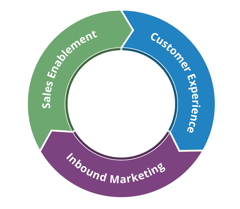The marketing department's role has been undergoing a rapid transformation in today's ever-changing marketing landscape, and it's more important than ever that marketers cultivate a culture that is genuinely focused on the customer experience. The concept of customer centricity should be the center of your marketing strategy. So what is customer centricity? It is a strategic approach in marketing where the primary focus is on providing a positive and personalized experience for the customer at every touchpoint. Instead of just driving sales, it's about building long-term relationships and understanding individual customer needs and preferences.
This mindset ensures that products, services, and marketing strategies are tailored to meet and exceed customer expectations, increasing loyalty, advocacy, and business growth. This concept should focus on the customer and their needs and wants and what the data and analytics on your customers can provide to help guide your marketing strategy.
There are four considerations we have found to be the most beneficial when evaluating and improving your customer-centricity strategy:
- Move from market share to share of wallet: Share of wallet, at the most basic level, is how the overall expenditure goes to one company over another. This is about how you can acquire new customers while expanding the revenue you are receiving from existing customers.
- Understand the difference between product lifecycle and customer lifecycle (and why customer lifecycle is more important in most cases): A product goes through a typical lifecycle of introduction, growth, maturity, and decline. Whereas, if you think about the lifecycle of a customer, they start as a prospect, move to a first-time customer, and can continue to be a repeat customer over time. This means you can continue to drive revenue from existing customers as long as you listen to their needs.
- Move from "the customer is always right" to "the customer is right if they are profitable:" As difficult as it may be for a customer to hear, not all customers are created equal. Most companies are now tracking the revenue per customer, and their customer service level likely depends on their value to the company. While this may seem harsh, every customer can only sometimes be right, so every customer can't be treated equally. All customers should be heard, but those impacting your revenue and your product lifecycle are the most likely to get the best customer service experience.
- Focus on customizing your marketing to move from mass messaging to personalized messaging: Marketers should be doing this already, but if they still need to, customers and prospects expect their marketing is going to be customized. For example, if you abandon a shopping cart and get an email an hour later, you expect that email to have the product you just viewed in the email. If it is a generic email or, even worse, a product you didn't even view, the likelihood of that email impacting a sale is slim. Think about how you can customize your marketing between email, automation, SMS, website content, sales content, and so much more.
How can data and analytics help you become more customer-centric?
- Measure your customer lifetime value (the value or profit that any customer provides to a company over time)
- Understand your segmentation, targeting, and positioning. Consider leveraging technology to gather and analyze this data to help you make better decisions.
- Measure customer preferences through surveys. You can do these through simple NPS (Net Promoter Score) surveys or in-depth fact-finding surveys.
- Discover emerging data sources and analytics through Google Trends and even AI. You can gather a lot of information that needs to be more specific to your data sources, but it will help you make longer-term decisions based on industry-wide trends.
In today's highly competitive market landscape, it's required to offer more than just a product or service, as your customer's experience and satisfaction are paramount. To thrive, marketers must deeply embed customer centricity into their strategy. This means going beyond transactional interactions and cultivating meaningful, lasting relationships. By truly understanding their customers' needs, preferences, and pain points, marketers can design tailored experiences that resonate and create lasting value. Implementing customer-centric approaches requires continuous listening, data-driven insights, and agile adaptations. Marketers who prioritize their customers at the core of their actions will foster loyalty and drive sustainable business growth in the long term.
If you're looking to discuss your customer experience strategy and how you can implement this as part of your overall marketing program, we invite you to schedule a consultation with our team, and we can discuss your customer growth goals.


__Square.png?width=250&height=250&name=Marketing_Hub_(1)__Square.png)




.png?width=250&name=diamond-badge-color%20(1).png)
